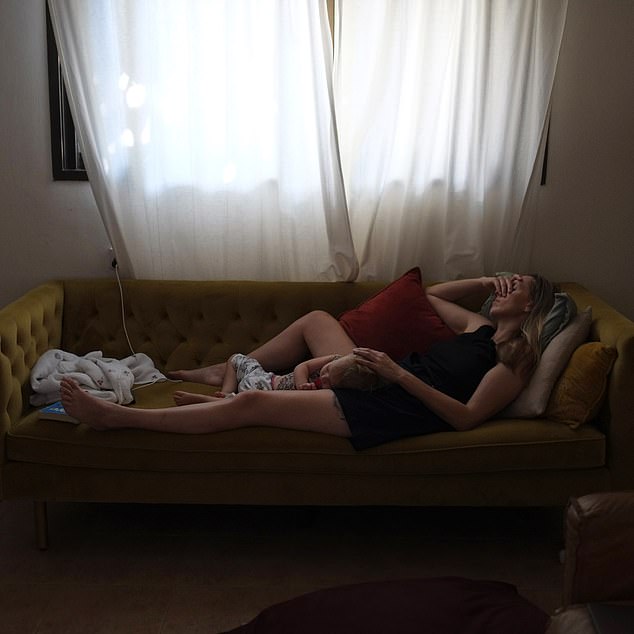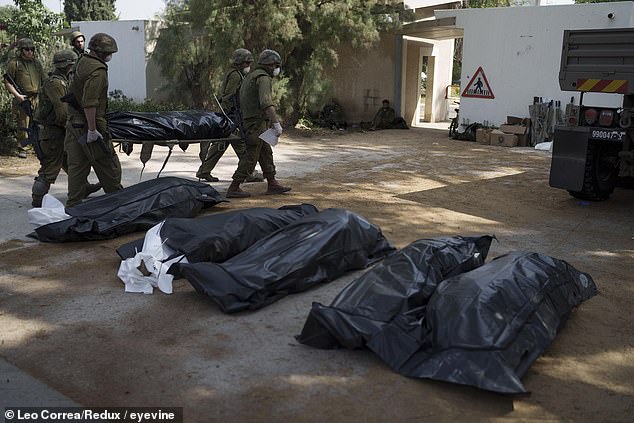One survivor of the Israeli terror attacks tells her incredible story and why she still hopes for peace: ‘My neighbour shot one terrorist, then grabbed his Kalashnikov and shot dead several others… I am only alive by a series of miracles’
Sometimes, between rocket attacks, there were months when Sofie Berzon Mackie thought she was living in a piece of paradise: a loving community in a beautiful countryside on the edge of the magical Negev desert.
The mother of three jogged across the fields and looked towards the Gaza border, just two miles away.
She would see the city, see the sea and one day be filled with the hope of peace – knowing that like her, there would be mothers on the other side of the fence who also wanted peace.
‘I’ve been left-wing all my life. I don’t believe in violence. I have always wanted coexistence,” says the British-Israeli artist.
“Even in our darkest hours, I told my children that in Gaza there were mothers like me, and children like them, and that they are not the devil. Now I realize how naive I was.
Sofie Berzon Mackie, 39 years old, mother of three children, has lived in the kibbutz for more than thirty years
‘There is still a part of me that wants peace, of course I do. But these monsters – Hamas – must be defeated. And the world must help us.
‘What they did happened once. It happened to us. But it can happen to you too. I have never seen or heard such hatred as on October 7.”
Berzon Mackie, 39, born in Be’eri, has spent most of her life as a member of the kibbutz where her parents – a British mother of Scottish descent and an Israeli father – met.
The family moved to London but returned to Be’eri when she was seven. Two months after her arrival – ‘a little English girl who didn’t speak a word of Hebrew’ – she lost her mother to a particularly aggressive form of cancer.
Just days later, the war in Iraq began, with Saddam Hussein firing rockets into Israel to provoke the country into war.
“And that was my introduction to Israeli life,” Berzon Mackie says with a shrug.
The people in the community became more than neighbors. They were family and helped raise her and her three siblings.
Founded by secular pioneers in 1946, the kibbutz, like many, had an ethos based on socialism, with a successful printing business and members who always shared the income and ate together like a big family.
The most demonic creatures in mythology don’t come close to what Hamas did
They were – are – peacemakers, derided by some as idealists in a country that is increasingly moving to the right after twenty years of particularly violent conflict with the Palestinians.
Members regularly drove to the Gaza border to transport children to hospital treatment in Israel.
They employed Palestinians when the border was open to vetted workers, and continued to pay them wages when the border was closed during increasingly frequent conflicts.
For some on the kibbutz, those Gazans felt like a larger part of the community.
Despite or because of the rocket fire between Gaza and Israel, they all thought they knew how the other felt.
When the siren went off in Be’eri, they had fifteen seconds to run into a bomb shelter or safe room, where they routinely saw the return attacks as the impact hit Gaza.
The members had all kinds of jobs. Another Briton – Lianne Sharabi, who was murdered along with her daughters Yahel (13) and Noiya (16) – ran the dental practice. Others commuted to nearby towns.
Berzon Mackie had a gallery in the kibbutz, where Israel’s best contemporary art was offered for sale around the world. The gallery is now gone, set on fire by some of the two hundred or so Gaza terrorists who maimed and murdered everyone, destroying everything in their path that terrible first Saturday in October.
The morning we spoke, at a hotel near the Dead Sea where the community has moved, she called the Israeli culture department to get the financing, but they need her accounts to start the paperwork, ‘and my accountant has been kidnapped’.

Sofie at home with daughter Danica last year in the house where she escaped the Hamas attack
The bureaucracy seems stubbornly unmoved, even by the greatest slaughter of Jews since the Holocaust.
Of the 1,200 inhabitants, more than 100 have died, while scores are missing. Bad news is coming in every day, as bodies burned beyond recognition are identified through DNA.
Others return from Gaza in body bags. “So many people I know are dead,” Berzon Mackie said. ‘So much. So much.’
The kibbutz was awakened on the morning of October 7 by sirens and, very quickly, rockets.
“The explosions sounded different, louder,” Berzon Mackie remembers. With her partner Tal, she woke up her eldest daughter, Anna, 12, grabbed three-year-old daughter Danica and ran into her son Thomas, nine,’s room – also the family’s safe room, which had walls fortified against rocket attacks. .
“We have a kibbutz WhatsApp and soon word went around that there were terrorists in the kibbutz and that we had to close the shutters of the houses and lock the doors – ridiculous things that were of no use to anyone,” says Berzon Mackie.
She lives in the center of the circular kibbutz. Her neighbors started writing about what was happening on the outer rings.
“They (the terrorists) went from house to house and slaughtered everyone,” Berzon Mackie said.
‘People left messages on the WhatsApp group, shouting and begging for help. One mother filmed herself crying hysterically as they shot her baby in the head. The craziest, unimaginable things.’
If there hadn’t been a small wall between us and the shrapnel, we would have been dead
When they couldn’t get into people’s safe rooms, they used hand grenades to try to open the doors.
And if that didn’t work, they would take the tires out of the cars and set them on fire in the houses to create a poisonous gas – so that people would leave their safe rooms and be either tortured, killed or kidnapped. Or they just burn houses down.
‘Only a few managed to escape by jumping from the second floor windows. We could hear the shooting and everything getting closer. They broke into my neighbors’ houses – two of them are dead. I live only by a series of miracles.’
The first of those miracles was a brave neighbor who had a gun and managed to surprise the terrorists when a van of seven of them arrived outside. He shot one, then grabbed his Kalashnikov and shot several other intruders.
After that, no one approached their corner of the neighborhood. For the first twelve hours, the family stayed as quiet as possible in the dark in their safe room. (“There was no electricity, we had no water, no food, we were sweating.”)
After the Israeli army’s failed attempt to relocate them, Berzon Mackie’s neighbor and her toddler joined them in the safe room.
‘There was no water in the taps, but we managed to get some ice cubes that were still frozen and sucked on them; When you’re full of adrenaline, you get very thirsty.
“We tried to convince the kids to go to sleep while the rest of us waited there in complete darkness.”
The army initially arrived at 6:30 PM – exactly twelve hours after the terror began – but this was not the end of their hell.
‘They came to evacuate us and the family living upstairs and formed a shield around us. Then the siren went off and we all fell to the ground.
‘I shouted at my children to lie down and protected them with my body. A rocket landed meters in front of me. Without a small concrete wall between us and the shrapnel, we would have been dead.
‘Then the terrorists started shooting – I heard the bullets whizzing past – so the army ordered us back to the safe rooms. We didn’t see them again until half past eleven.’

In the kibbutz Kfar Aza, Israeli soldiers treat the dead after the October 7 atrocities
By the time the army returned, the family was so scared they wouldn’t answer the door – their neighbors had been tricked by terrorists dressed as soldiers – but they eventually left with a change of clothes, a toothbrush and a favorite toy.
“They were still shooting at us; we had to stop every few minutes and lie down on the ground,” says Berzon Mackie.
‘The scene was straight out of a movie: the sky was red, the smell incredible. Dead bodies were everywhere. We walked through puddles of blood.”
They were taken to another kibbutz, after which the community regrouped in a hotel on the Dead Sea. Every day they receive new lists of the dead, after DNA testing. There are still many missing people.
She can’t sleep. Her children did not eat for days. Her youngest clings to her day and night. Outwardly calm, Berzon Mackie has an inner anger that rises as she discusses what Hamas has done to friends and neighbors.
‘I want peace, but after this sadistic, perverse attack I don’t know if that is possible. What they did was beyond words, even beyond what the Nazis did. Mythology’s most twisted, demonic creatures don’t come close to doing what they did.
‘They cut open pregnant women and killed babies that were still stuck inside. They tortured babies and beheaded children. They tied people up and burned them alive. Even the Nazis wanted to kill quickly; these men took the time to torture children.
“They are the most violent organization in human history, and this cannot be our future. They cannot exist in the world we give our children.
“I understand the legitimate cry of the Palestinian people for independence and a good life – I want that for them too – but what these monsters did was a crime against humanity, nothing to do with a state.”
Despite the horrors, Berzon Mackie hopes to one day return to Be’eri. It is where the dead are buried. Families are taken to and from the kibbutz cemetery by the army, because the entire area is still not safe.
The morning we spoke, Berzon Mackie was told she had won a Spanish photography award for the photos she took of her house. “Now I don’t even know if it’s still standing,” she says.
Her hope is not gone, but it is brighter. “I still feel positive about our future,” she says, “but I now know that we must go to war to achieve peace.”
- For more information about Sofie Berzon Mackie’s visual artistry and details of her blog, visit her website, sofiemackie.com
